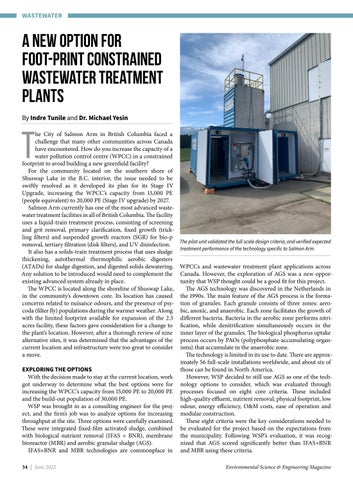WASTEWATER
A new option for foot-print constrained wastewater treatment plants By Indre Tunile and Dr. Michael Yesin
T
he City of Salmon Arm in British Columbia faced a challenge that many other communities across Canada have encountered. How do you increase the capacity of a water pollution control centre (WPCC) in a constrained footprint to avoid building a new greenfield facility? For the community located on the southern shore of Shuswap Lake in the B.C. interior, the issue needed to be swiftly resolved as it developed its plan for its Stage IV Upgrade, increasing the WPCC’s capacity from 15,000 PE (people equivalent) to 20,000 PE (Stage IV upgrade) by 2027. Salmon Arm currently has one of the most advanced wastewater treatment facilities in all of British Columbia. The facility uses a liquid-train treatment process, consisting of screening and grit removal, primary clarification, fixed growth (trickling filters) and suspended growth reactors (SGR) for bio-p removal, tertiary filtration (disk filters), and UV disinfection. It also has a solids-train treatment process that uses sludge thickening, autothermal thermophilic aerobic digesters (ATADs) for sludge digestion, and digested solids dewatering. Any solution to be introduced would need to complement the existing advanced system already in place. The WPCC is located along the shoreline of Shuswap Lake, in the community’s downtown core. Its location has caused concerns related to nuisance odours, and the presence of psycoda (filter fly) populations during the warmer weather. Along with the limited footprint available for expansion of the 2.3 acres facility, these factors gave consideration for a change to the plant’s location. However, after a thorough review of nine alternative sites, it was determined that the advantages of the current location and infrastructure were too great to consider a move.
The pilot unit validated the full-scale design criteria, and verified expected treatment performance of the technology specific to Salmon Arm.
WPCCs and wastewater treatment plant applications across Canada. However, the exploration of AGS was a new opportunity that WSP thought could be a good fit for this project. The AGS technology was discovered in the Netherlands in the 1990s. The main feature of the AGS process is the formation of granules. Each granule consists of three zones: aerobic, anoxic, and anaerobic. Each zone facilitates the growth of different bacteria. Bacteria in the aerobic zone performs nitrification, while denitrification simultaneously occurs in the inner layer of the granules. The biological phosphorus uptake process occurs by PAOs (polyphosphate-accumulating organisms) that accumulate in the anaerobic zone. The technology is limited in its use to date. There are approximately 56 full-scale installations worldwide, and about six of EXPLORING THE OPTIONS those can be found in North America. With the decision made to stay at the current location, work However, WSP decided to still use AGS as one of the techgot underway to determine what the best options were for nology options to consider, which was evaluated through increasing the WPCC’s capacity from 15,000 PE to 20,000 PE processes focused on eight core criteria. These included and the build-out population of 30,000 PE. high-quality effluent, nutrient removal, physical footprint, low WSP was brought in as a consulting engineer for the proj- odour, energy efficiency, O&M costs, ease of operation and ect, and the firm’s job was to analyze options for increasing modular construction. throughput at the site. Three options were carefully examined. These eight criteria were the key considerations needed to These were integrated fixed-film activated sludge, combined be evaluated for the project based on the expectations from with biological nutrient removal (IFAS + BNR), membrane the municipality. Following WSP’s evaluation, it was recogbioreactor (MBR) and aerobic granular sludge (AGS). nized that AGS scored significantly better than IFAS+BNR IFAS+BNR and MBR technologies are commonplace in and MBR using these criteria. 34 | June 2022
Environmental Science & Engineering Magazine








